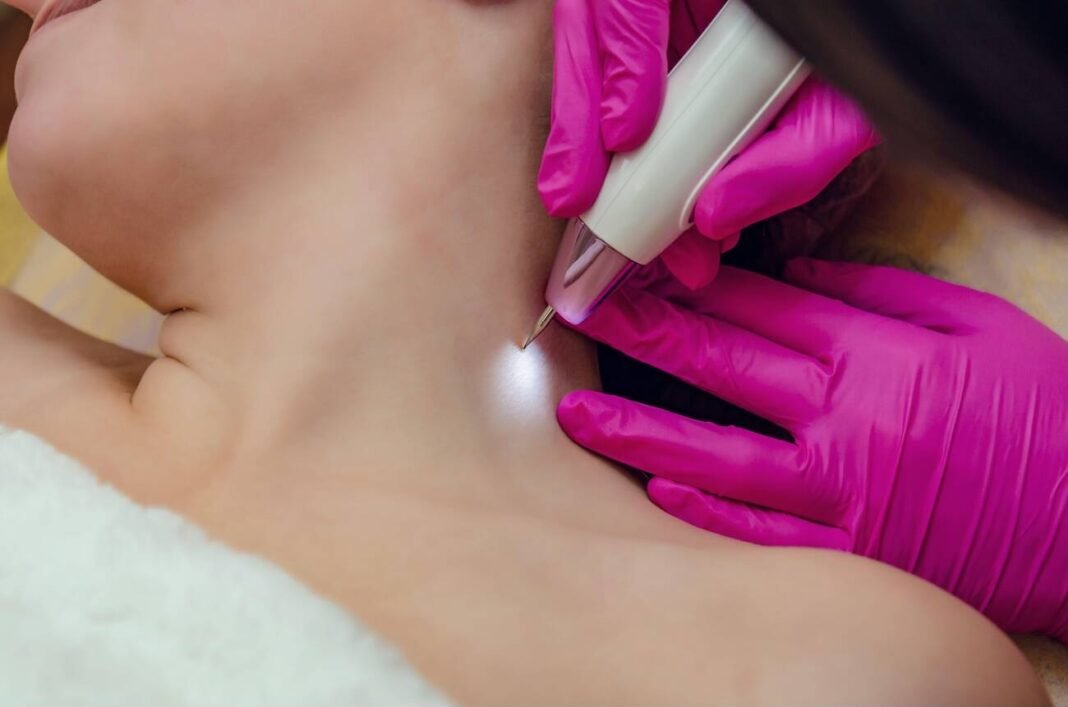Skin tags, benign growths that hang from the skin’s surface, are a common dermatological concern for many. Although they are generally harmless, their appearance can lead to discomfort and self-consciousness, driving individuals to seek skin tag removal options. Unfortunately, with the plethora of treatments available, ranging from clinical procedures to at-home remedies, choosing the most effective skin tag remover can be overwhelming. Recognizing the significance of this issue, our comprehensive guide is designed to navigate the various methods of skin tag removal, offering clarity and direction for those affected.
This article will delve into the intricacies of skin tags, exploring their causes and why removal might be considered. We will compare professional skin tag removal methods, such as skin tag removal on eyelid and skin tag on anus removal, assessing their efficacy and cost. Additionally, for those curious about how to remove a skin tag from the comfort of their home, we will evaluate at-home remedies, including skin tag removal kits, patches, and home remedies for skin tags. By presenting a balanced overview of available treatments, this guide aims to empower readers with the knowledge to choose the most appropriate skin tag removal strategy for their specific needs.
Understanding Skin Tags and Their Causes
Definition and Characteristics of Skin Tags
Skin tags, medically termed as ‘acrochordons,’ are benign skin growths that typically appear as small flaps hanging off the skin. These noncancerous growths are composed of collagen fibers and blood vessels wrapped in a thin layer of skin. Often found in areas where skin rubs against skin, such as the neck, armpits, and groin, they can range in size from 1mm to several centimeters.
Common Causes and Risk Factors
The development of skin tags is primarily associated with skin friction and is prevalent in areas like the eyelids, underarms, and other folds of the skin. Factors that increase the likelihood of skin tags include obesity, diabetes, and pregnancy due to increased friction and hormonal changes. Age is also a significant factor, as skin tags are more common in older adults. Genetic predisposition and conditions like metabolic syndrome also contribute to their occurrence.
Why Removal Might Be Considered
While skin tags are generally harmless, they can be removed for cosmetic reasons or if they cause discomfort or irritation. Areas prone to irritation, such as eyelids or underarms, might necessitate removal if the skin tags affect daily activities or become painful.
Professional Skin Tag Removal Methods
Cryotherapy: Freezing Off Skin Tags
Cryotherapy is a popular method where skin tags are frozen using liquid nitrogen. The process involves applying the nitrogen with a cotton swab or spray, causing the tag to freeze and fall off within days. This method is favored for its minimal damage to surrounding tissues and is suitable for sensitive areas like eyelids.
Excision: Cutting Off Skin Tags
Excision involves removing skin tags using scissors or a scalpel. This method is direct and effective, especially for larger skin tags, providing immediate results. It’s important that this procedure is performed by a healthcare professional to prevent infection.
Electrocautery and Cauterization: Burning Off Skin Tags
Electrocautery uses electric currents to burn off skin tags, sealing the wound simultaneously to prevent bleeding and infection. Cauterization involves a similar process of burning, often requiring several treatments for complete removal. Both methods are quick and effective, typically carried out in a dermatologist’s office.
Ligation: Cutting Off Blood Supply
Ligation involves tying off the skin tag at its base with a surgical thread, cutting off blood supply. This causes the tag to die and fall off over time. This method is less invasive and can be an option for those looking to avoid surgical procedures.
At-Home Remedies for Skin Tag Removal
Safety Precautions and Risks
At-home skin tag removal carries significant risks. The U.S. Food and Drug Administration (FDA) has not approved any over-the-counter skin tag removal products, warning against potential harm. Improper use can lead to severe skin irritation, bleeding, or infection. Dermatologists caution against self-removal, particularly with methods like cutting or tying off, which can cause heavy bleeding or infection.
Effective Natural Remedies and Their Application
While natural remedies like tea tree oil and apple cider vinegar are popular online, they often do not yield effective results and can cause irritation or allergic reactions. Over-the-counter freezing kits may seem convenient but typically require multiple applications and may not be as effective as professional treatments. It is crucial to consult with a healthcare provider before attempting any home treatment.
When to See a Doctor Instead of Using Home Remedies
If a skin tag is bothersome, changing in appearance, or located in a sensitive area such as the eyelids or genital region, it is advisable to consult a doctor. Professional removal in a medical setting is safer and ensures proper diagnosis and treatment, avoiding the risks of misdiagnosis and complications associated with home remedies.
Conclusion
Navigating the myriad of options for skin tag removal can be a daunting task, yet this guide serves as a comprehensive resource to demystify the process, outlining both professional and at-home remedies. By understanding the nature of skin tags, including their causes and implications for removal, individuals are better equipped to make informed decisions. Particularly, the exploration of professional techniques versus at-home treatments underscores the importance of considering safety, efficacy, and the potential for side effects, enabling readers to weigh these factors in selecting the most appropriate course of action for their specific situation.
The significance of consulting with a healthcare provider cannot be overstated, especially when considering the removal of skin tags in sensitive or high-risk areas. Professional intervention ensures accuracy in diagnosis and treatment, minimizing the risks associated with self-removal methods. Ultimately, the journey to removing skin tags, whether pursued at home or in a clinical setting, should be approached with caution and informed understanding, taking into account the potential consequences and benefits to ensure the healthiest and most aesthetically pleasing outcome.
FAQs
1. What is the most effective method for removing skin tags?
The most effective methods for skin tag removal include cryotherapy and electrocautery. Cryotherapy involves freezing the skin tag with liquid nitrogen, typically performed by a dermatologist. Electrocautery involves burning the skin tag using an electric probe or needle.
2. Are there any effective skin tag removers available?
Yes, effective skin tag removers include cauterization and cryotherapy. Cauterization involves burning the skin tag, usually requiring a few treatments for complete removal. Cryotherapy uses liquid nitrogen to freeze the skin tag, generally effective within one or two treatments.
3. What treatments do dermatologists recommend for removing skin tags?
Dermatologists often recommend cryosurgery for skin tag removal. This procedure involves applying liquid nitrogen to freeze and destroy the skin tag. The treatment may result in a blister or scab, which falls off along with the skin tag.
4. What are some natural remedies that can eliminate skin tags?
Several home remedies are known to help remove skin tags naturally:
- Tea tree oil: When diluted in a carrier oil, it’s safe for skin application due to its antiviral and antifungal properties.
- Banana peel: Useful for skin tag treatment; simply place a piece of banana peel on the tag.
- Apple cider vinegar: Known for its skin benefits, it can be applied to skin tags.
- Vitamin E: Helps in skin tag removal when applied directly.
- Garlic: Direct application of crushed garlic or garlic extract can be effective.


